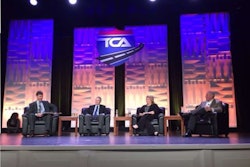 Panelists discussed strategies to attract and retain women drivers. From left: Lisa Pate, U.S. Xpress; Amber Edmondson, Trailiner;Brooke Mosley, Prime Inc.; Tim Hindes, Stay Metrics; Sherri Garner Brumbaugh, Garner Trucking.
Panelists discussed strategies to attract and retain women drivers. From left: Lisa Pate, U.S. Xpress; Amber Edmondson, Trailiner;Brooke Mosley, Prime Inc.; Tim Hindes, Stay Metrics; Sherri Garner Brumbaugh, Garner Trucking.At the Truckload Carriers Association annual convention in Las Vegas, Mar. 8, a panel of fleet executives discussed strategies to attract more women drivers into the trucking industry. The panel was organized by Women in Trucking.
“I think for women (driving) is a great job. It is a great opportunity to have a good paying job with benefits. Those are few and far between out there,” said Sherri Garner Brumbaugh, president of Garner Trucking, Inc., a 100-truck carrier based in Ohio.
Amber Edmondson, president of Trailiner Corporation, a family-owned truckload carrier based in Springfield, Mo., emphasized the low barrier of entry and the level playing field for income.
“You can go to most training programs for free or paid for by a company so you don’t have to spend thousands of dollars on an education to come into an equal pay position,” she said.
Women make up 57 percent of the workforce in the United States, but the trucking industry is much different; only six percent of drivers are women. Why does there appear to be a lack of interest in a career that pays between $60,000 and $80,000 a year?
“I’m not sure the issue is that young women feel like they can’t drive a truck,” said Lisa Pate, chief administration officer of U.S. Xpress. “I think the issue is that young women and young men really don’t want to drive a truck. How do we change the aspects of the job to make it more attractive? This is not a short term problem.”
More work needs to be done with scheduling and routing to get drivers home on time and remove the variability from their workday, the panelists agreed.
“The lack of a schedule and predictability is very disruptive and not attractive to people,” said Pate, who is the daughter of the late Patrick Quinn, co-founder of U.S. Xpress. “That will help to attract women and the younger generation.”
Pate advised fleets to have team operations for women drivers for added protection. More than 50 percent of women drivers at U.S. Xpress run with a spouse or another woman driver, she said, and the company allows drivers to take pets on the road for the same reason.
“One of the complaints we often hear from women is ‘I just don’t feel safe.’ They don’t feel safe out on the road,” she said.
All panelists agreed that women drivers, and more generally any driver who is getting started in the industry, should be given proper training to understand the work lifestyle and to set the right expectations.
“Traditionally people fail because they didn’t know the expectations,” said Garner Brumbaugh.
U.S. Xpress puts inexperienced drivers through an extra day of student orientation training, Pate said. This decision was made after its exit interviews revealed that a number of drivers were quitting because they no longer wanted to be a truck driver.
“We spend an extra day of prepping and lifestyle coaching. We are not making any assumptions about what they know and don’t know,” she said.
Springfield, Mo.-based Prime, Inc., one of the largest flatbed and refrigerated carriers in the country, has a training specialist and female driver liaison in Brooke Mosley. The company trains new drivers on what to eat on the road, what to expect at truckstops, and many other areas to help prepare for the job and set realistic expectations.
“You can never give them too much information,” Mosley says. The female drivers at Prime, Inc., can also call her any time to ask questions and get any extra help they might need.
Fleets that are successful in recruiting and retaining women drivers are seeing payoffs. Women drivers tend to have a lower turnover rate than men, said Mosley, who has also noticed that women tend to do more research about the companies they apply to work for. “When they walk through your door on that first day, they’ve made a decision.”
Panelist Tim Hindes, chief executive officer and founder of Stay Metrics, said the company’s research shows that female drivers are better listeners and have better relationships with their dispatchers. He also said female drivers tend to have the key personality trait of orderliness which correlates with lower turnover in trucking.
Stay Metrics provides surveys, analytics and engagement programs that increase driver retention for clients in the trucking industry, he said. The panel was moderated by Ellen Voie, president and chief executive of Women in Trucking Association, with a mission to encourage employment, promote accomplishments, and minimize the obstacles faced by women working in the trucking industry.










